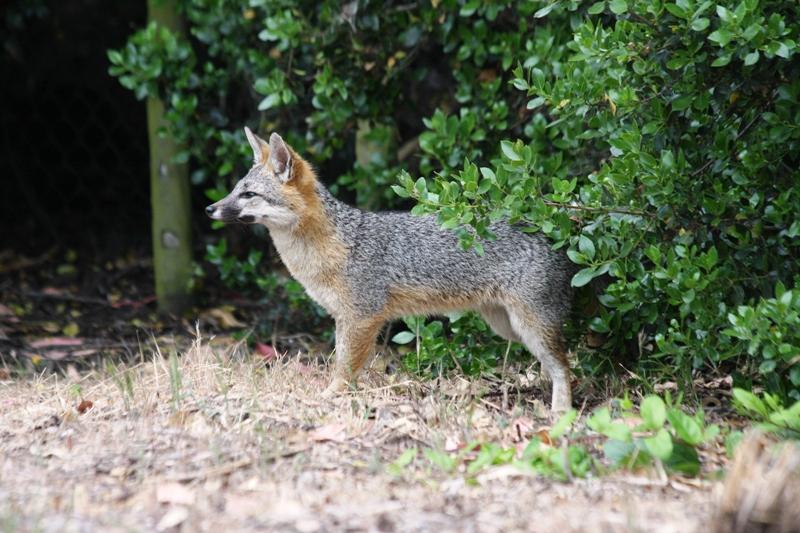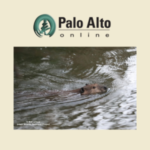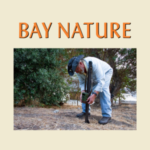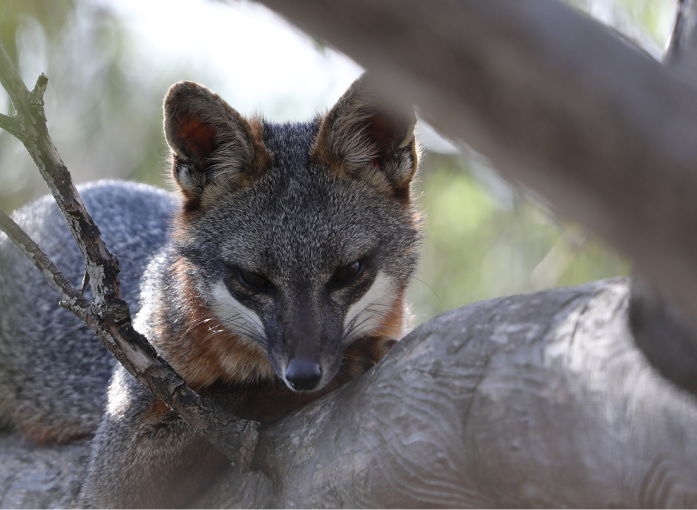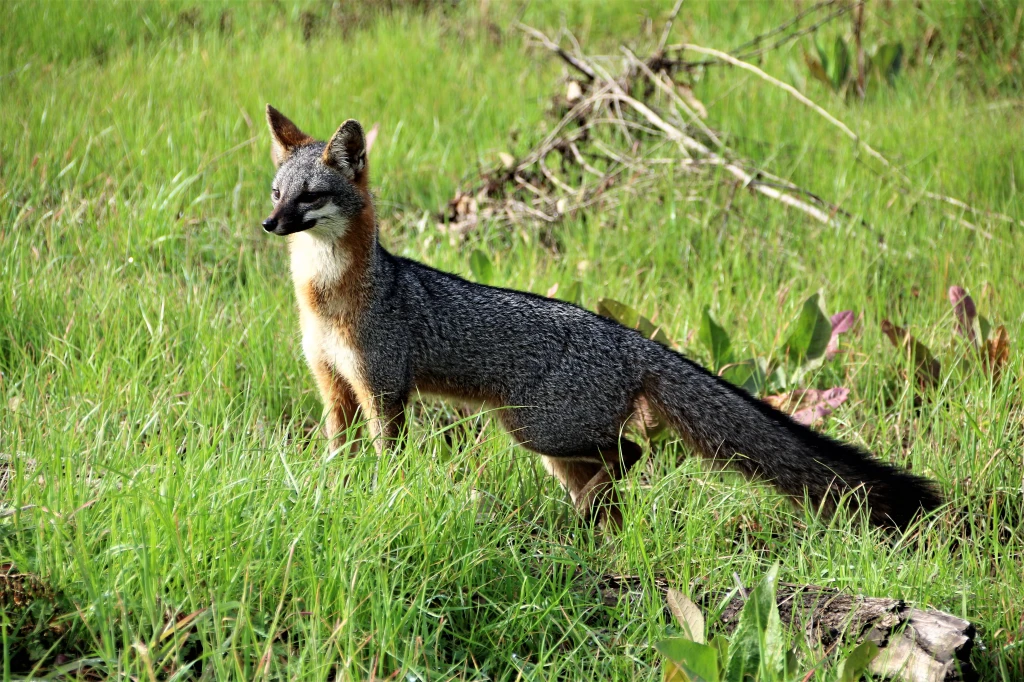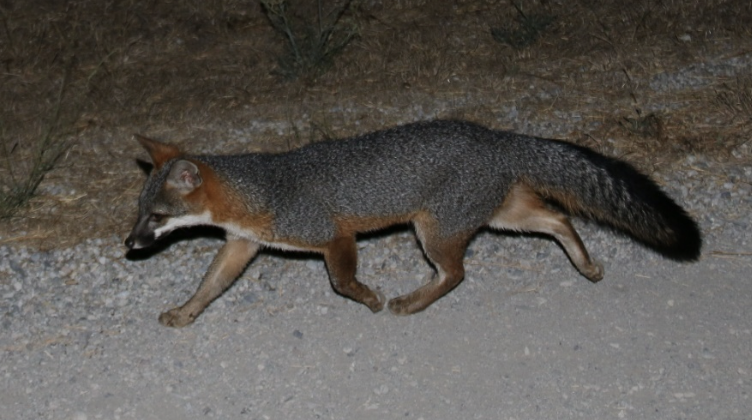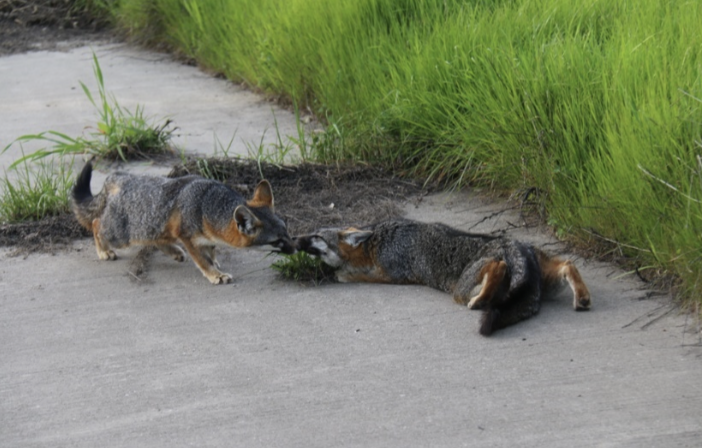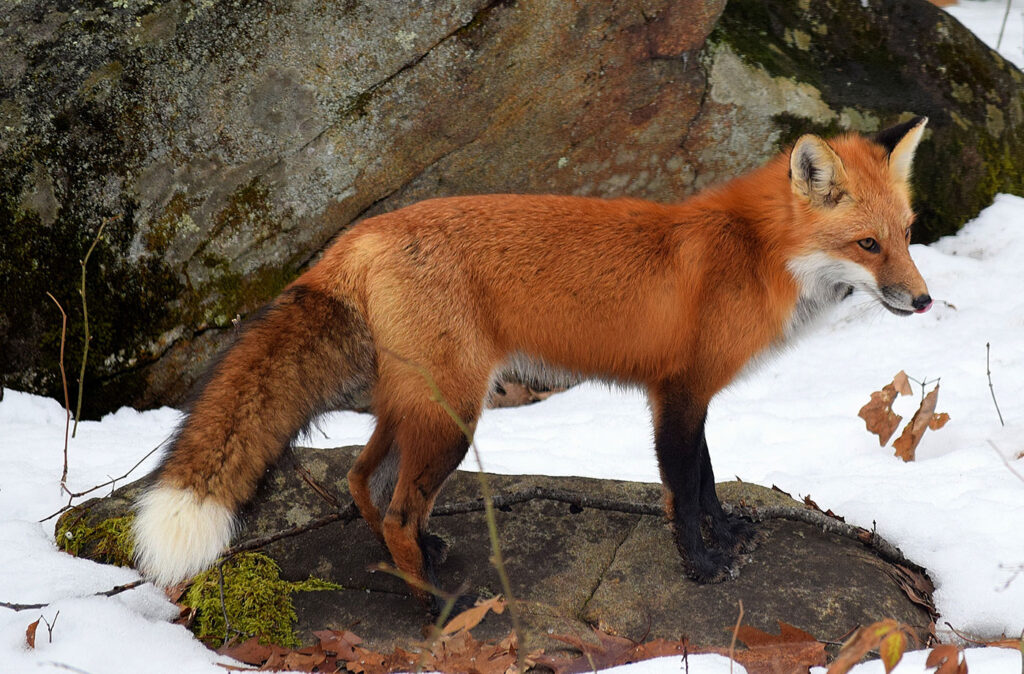by William C. Leikam
President, CEO & Co-founder, Urban Wildlife Research Project
Be sure to check out the interview Bill did with Alie Ward for her internationally acclaimed podcast Ologies https://www.alieward.com/ologies/urocynology. More about this below.
What I’ve Learned About Gray Fox Behavior
Part 5 – The Nose Knows: Hunting
If you have a dog and you take your dog on walks around the neighborhood, or out along the trail in a park, you’ve likely noticed that on occasion, your dog will want to stop and sniff at something that makes you wonder, “What’s he after?” Although your dog can’t see it, he sure can smell and when he stops you for a sniff, he is picking up large amounts of information, such as there’s a new male dog in the neighborhood and he was here two days ago, or your dog may well be identifying local dogs and he knows when they stopped off there and left their mark. Once your dog has sniffed and gathered all that information and much more, he urinates on the spot. What’s he doing? He’s leaving a message and that message is likely to be something like, “I was here, too.” The next dog to come along may well recognize the odor, recognize having met your dog on previous walks. It’s like saying, “Hey, I know you. You’re part of our neighborhood.”
Their nose is a complex of olfactory nodes that take in the scent and then process the meaning of that scent in the olfactory cortex. We humans have approximately 6 million nodes in our olfactory system. We’re pretty wimpy when it comes to this, because your pet dog has anywhere from 125 million to 300 million such nodes, depending upon the breed.
Before I knew too much about the gray fox (Urocyon cinereoargenteus), I watched them moving along trails, dirt roads, and people paths. I was struck by the fact that roughly 95% of the time they had their nose to the ground. I wondered about that for upwards of a year until one early morning while monitoring the gray fox male Gray, he abruptly stopped trotting, walked to the edge of the dirt road where tall grasses grew, and he froze, motionless. Not a muscle moved. Two or three seconds later he lowered his hind quarters, tensed, and less than a second later he shot upward in a graceful arc and disappeared in the weeds. Seconds later, he emerged with a field mouse in his jaws.
 At first, I wondered how he could possibly do that without injuring his nose. It was explained to me that once they hit the top of that bounding leap, they extend their front legs out ahead of themselves and when the prey is picked up those front paws have broken the fall, allowing Gray to scoop up the mouse and carry it away for breakfast. (When I use such terms as this, we need to understand that their breakfast is at the end of our day).
At first, I wondered how he could possibly do that without injuring his nose. It was explained to me that once they hit the top of that bounding leap, they extend their front legs out ahead of themselves and when the prey is picked up those front paws have broken the fall, allowing Gray to scoop up the mouse and carry it away for breakfast. (When I use such terms as this, we need to understand that their breakfast is at the end of our day).
I was to find out that with such a sensitive nose, that if, say for instance a cottontail rabbit had crossed the road from one weeded area to another, that its fresh scent will linger on that road exactly where the rabbit had gone for upwards to several hours, and often more if weather conditions permit. I also discovered that the gray fox could tell by the scent of its prey whether it was worthwhile to try to catch it for dinner or not. If the scent was too old, Gray simply sniffed and ignored it because by then that little rabbit was no longer viable prey.
As I monitored these foxes, I saw how the pups mimicked their parents. As the pups developed, some foxes produced slight changes to the way they hunted. Not only that, but a hunting pattern emerged. When Mama Bold and Gray got their pups up to speed and able to hunt on their own, they all tended to hunt in the same area. But as they hunted the area, their prey became increasingly scarce. As that happened, they moved their hunting grounds to another nearby location that contained more prey until the number of preys got so low that once again, they moved on, repeating that pattern for their complete home range which in the Palo Alto Baylands Nature Preserve is about half a square mile. When they finally reduced the number of preys in that last region, they went back to the original region, for by then their prey had, had time to reproduce and thus repopulate the region with fox food. This is the way in which the gray fox helps to keep the ecosystem healthy and in balance.
Grey Fox General Health
There are no gray foxes in the Palo Alto Baylands Nature Preserve. However, there is a family of three red foxes that have moved into the territory along with a coyote pair. Presently, we are monitoring them.
Gray Fox, Baylands Goals
Within the permit that allows the Urban Wildlife Research Project to conduct its study of the behavior of the gray fox at the Palo Alto Baylands Nature Preserve, the objectives covered are:
- Monitoring of urban gray fox Denning sites in Palo Alto Baylands.
This is being accomplished during the period when the gray foxes use a den site. It is one of the prime locations for gathering most of the behavioral data of the litter and for adults alike.
- Assessment of status and population trends of Baylands urban gray foxes.
Since January 2019 a pair of resident gray foxes have claimed territory at the Palo Alto Baylands Nature Preserve.
- Identification of habitat features that promote the presence of urban gray foxes.
The Urban Wildlife Research Project is working on a project to remove the concrete from Matadero Creek that will create linkages and corridors between the Santa Cruz Mountain Range and the Palo Alto baylands..
- Assessment of reproductive success and identification of factors that promote successful reproduction.
Open the pinch-point along Matadero Creek by developing thickets that link one area to another, instead of the present island-like habitat.
- Identification and assessment of possible dispersal travel routes.
Dispersal routes move between the Palo Alto Baylands Nature Preserve and the Shoreline region over in Mountain View. In a north-westerly direction the dispersal corridors run just behind the homes bordering the marshlands in East Palo Alto.
What's Happening at UWRP?
We here at the Urban Wildlife Research Project are proud to announce that the Alie Ward interview for her podcast Ologies is now live. Her audience is between 300,000 and 400,000 people and for every episode she draws down approximately 3 million downloads.
Alie said, “Thank you so, so much for being on the show. This is one of my favorites and I’m so excited to have listeners get to know you and our little gray fox friends! We also plugged the non-profit, your book, and the documentary! Thank you for sharing your knowledge!” In the first 12 hours after release there were already 97,000 people who listened to this podcast.
The podcast can be accessed on any of the podcast “stations” online such as Apple, Spotify iHeart, Podbay, or here at her website https://www.alieward.com/ologies/urocynology. If you chose the website, scroll down the page to find out more. In the very beginning there is a short advertisement before she and I get into the fray of it all. Enjoy.
If you thought it worthwhile, please, spread the word through your personal networks.
On June 14, in the Elephant Room at Safari West, 7:00 PM, Bill will give a talk on the behavior of the gray foxes that he has studied over this past 15 years.
Be on the lookout for Bill being booked to give another talk over at Meta (Facebook). We’re working on it.
The Urban Wildlife Research Project will be present at Safari West for Earth Day on April 26th. Why not drop by our booth and say hello.
If you or your organization would like to have Bill aka the Fox Guy present one of his four PowerPoint presentations:
1. A Year with the Urban Gray Fox – MOST POPULAR
2. Human Development, Sixth Mass Extinction & Gray Foxes – An historical look at how we got to our present place in history.
3. Gray Fox Cognition – What & How Gray Foxes Perceive – This is an attempt to get inside the mind of a gray fox
4. Corridors & Connections – Sustaining the Health of Our Wildlife – The title says it all
Contact us here https://urbanwildliferesearchproject.org/contact/ and let us know.
Videos and Documentaries

My journey to the University of Zurich, Switzerland, Triggered By Motion

Bill’s book The Road to Fox Hollow can be purchased directly from Bill for a mere $20.00. Just email him through the Contact form on the Urban Wildlife Research Project’s website, leave your email address and he will get back to you. Or you can contact the publisher Di Angelo Publications .
A video documentary about Bill’s work with the foxes and produced at Stanford University by Syler Peralta-Ramos.
What happens when an opossum and a red fox meet in the night?
In contrast to two other raccoon discipline videos, this one is rather mild.
Gray Fox Playfulness “Hugging” Behaviors.
See the violence of Discipline Raccoon Style.

“How to be a Fox” The article about Bill and his ethological approach to his study of the gray fox is online here. Many are calling this a major article in the wildlife press.
Be Sure to check out our YouTube Channel for some incredible wildlife videos.

